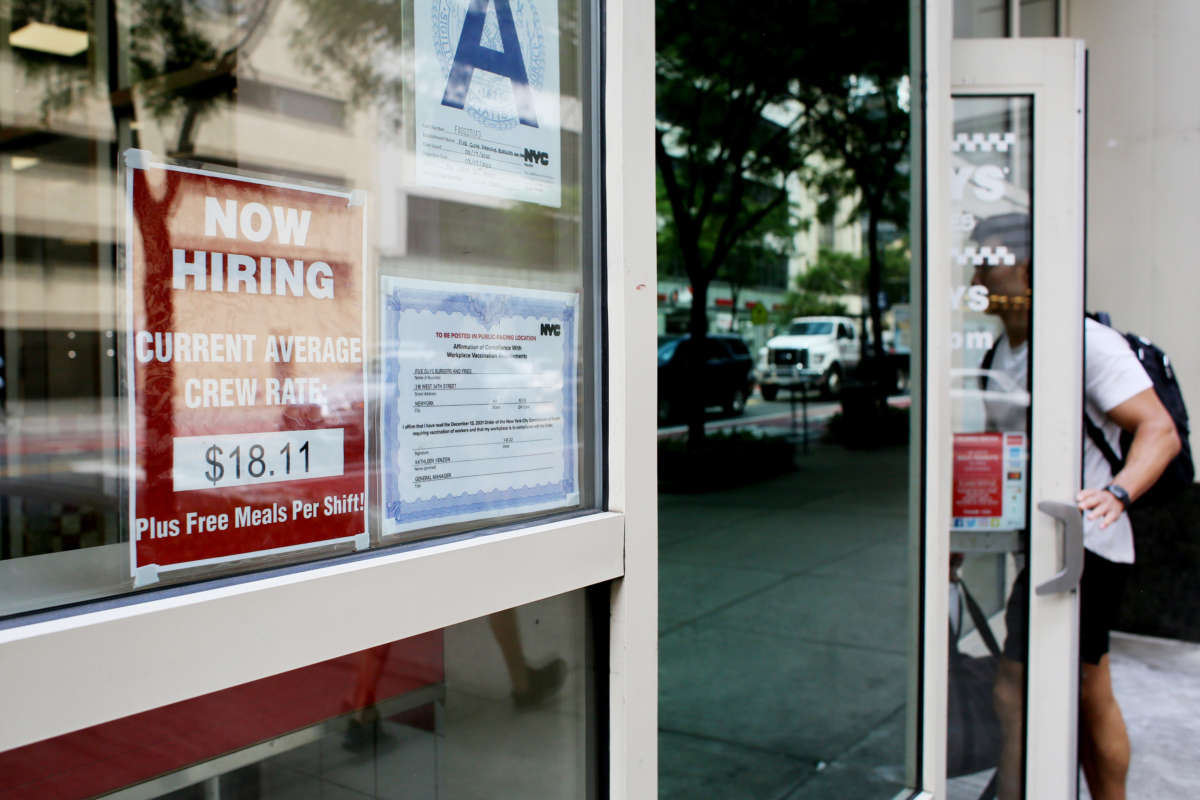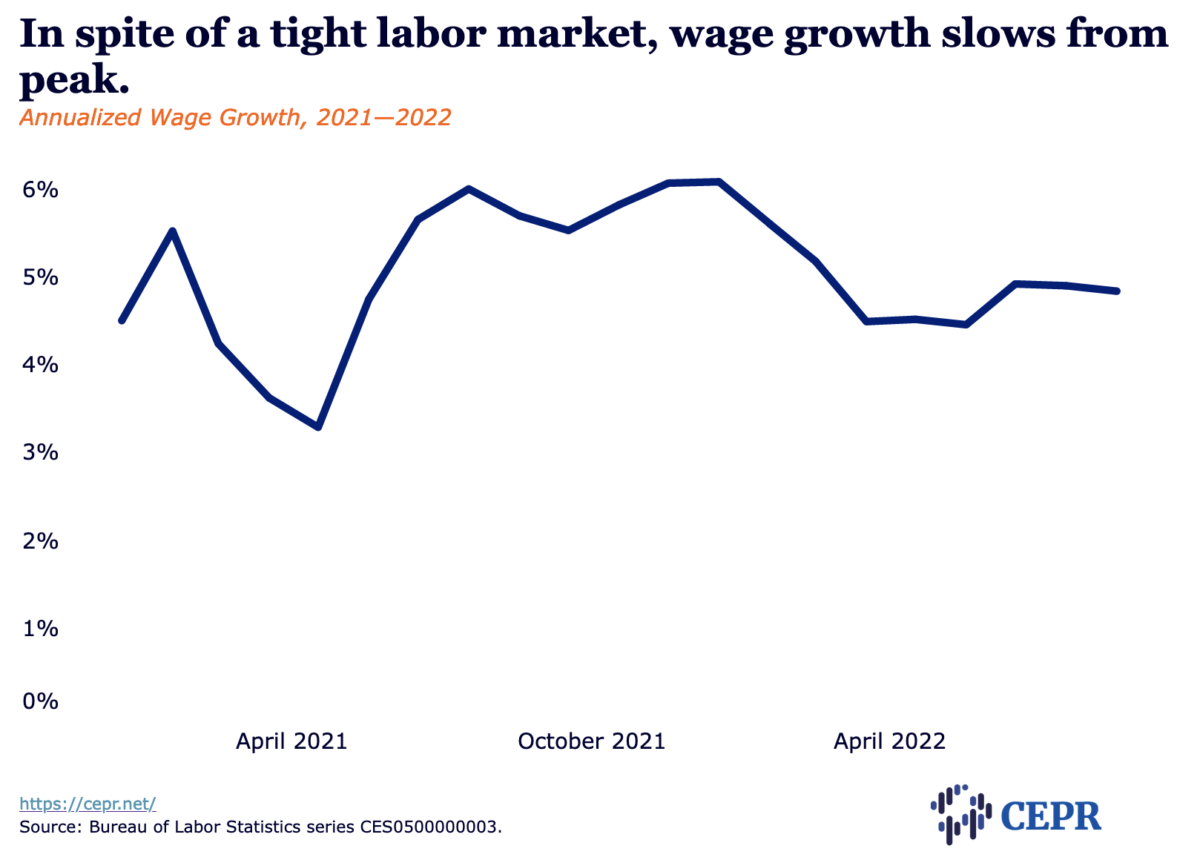Did you know that Truthout is a nonprofit and independently funded by readers like you? If you value what we do, please support our work with a donation.
The September employment report showed the labor market remains strong, however, wage growth appears to be moderating. The report showed a gain of 263,000 jobs, which is in line with most predictions. The unemployment rate edged back down to 3.5 percent, its lowest level in the last half-century.
Despite this strength, wage growth was just 0.3 percent in September, the same as in August. This is a pace that would be consistent with the Fed’s 2.0 percent inflation target.
The rate over a longer period is higher. Comparing the average for the last three months (July, August, September) with the prior three months (April, May, June), wages have been growing at a 4.8 percent annual rate.
However, this is down from a 6.1 percent pace at the start of the year. Wage growth is clearly slowing rather than increasing as Beveridge Curve models would predict given vacancy rates.
Black Unemployment Ties for Recovery Low, Hispanic Unemployment Hits Record Low
The Black unemployment rate fell to 5.8 percent in September, reversing recent rises and tying for the low point in the recovery. The unemployment rate for Black teens fell to 12.7 percent, the second lowest ever, and lower than any pre-pandemic level. The unemployment rate for Hispanics fell to 3.8 percent, the lowest rate on record.
Most of the data in the household survey were very positive. The unemployment rate for foreign-born workers fell by 1.0 percentage point to 2.9 percent. The U-6 measure of labor market slack fell to 6.7 percent, tying the record lows hit this summer.
Jobs Gains Widespread Across Sectors
Most sectors showed healthy job gains in September, with state and local governments being a notable exception. State and local government employment fell by 27,000 in September, partly reversing gains reported in August. This is likely largely a seasonal adjustment issue associated with changes in the timing of school openings. Still, state and local government employment is more than 600,000 below the pre-pandemic level. It is down 700,000 when adding the preliminary benchmark revision.
The flip side is that private sector growth has been more rapid. The private sector added 288,000 jobs in September. Employment is now 1.1 million above its pre-pandemic level, and more than 1.6 million higher, including the benchmark revision.
Construction Continues to Add Jobs, Manufacturing Jobs Nearly 100,000 Above Pre-Pandemic Levels
Construction added 19,000 in September, with even residential construction continuing to add jobs despite the plunge in housing starts. There is a huge backlog of unfinished homes due to supply chain problems, and workers are needed to complete them.
Manufacturing added 22,000 jobs in September. Employment is now almost 100,000 above the pre-pandemic level. It would be almost 120,000 higher with the benchmark revisions.
Airlines added 2,800 jobs in September, employment is now more than 50,000 (almost 10.0 percent) above the pre-pandemic level. Restaurants were again a big job gainer, adding 60,000 jobs. Employment in the industry is still 560,000 below the pre-pandemic level.
Nursing homes added 1,400 jobs, while childcare centers lost 2,000. Employment in the two sectors is now down from pre-pandemic levels by 14.1 percent and 9.7 percent, respectively.
Mixed Picture on Labor Force Participation Rate
After rising 0.3 percentage points in August, the labor force participation rate (LFPR) edged down by 0.1 percentage points in September. The LFPR edged up by 0.2 percentage points for prime-age (ages 25–54) men to 88.8 percent. This is 0.8 percentage points below pre-pandemic peak. For prime-age women, the LFPR fell 0.6 percentage points to 76.6 percent, 0.3 percentage points below pre-pandemic peak. These monthly changes are primarily noise, and it is likely that we will see rises through the fall bringing employment in the household survey more in line with job growth in the establishment survey.
Length of Average Workweek Unchanged
The average workweek was unchanged at 34.5 hours in September. This is slightly above the 34.4 average for 2019, but a level often seen before the pandemic. This is noteworthy because the workweek peaked at 35.0 hours in January of 2021 as employers, unable to hire more employees, worked their existing workers more hours. This is further evidence of a return to normal in the labor market.
Self-Employment Remains High
There was a big increase in self-employment in the pandemic, which is persisting even as the labor market returns to normal. The number of incorporated self-employed rose by 38,000 in September and is now more than 500,000 above the 2019 average. The number of unincorporated self-employed is more than 300,000 higher than the 2019 average.
Share of Unemployment Due to Voluntary Quits Hits Record Highs
The share of unemployment due to people voluntarily quitting their jobs rose to 15.9 percent. This is a clear measure of labor market strength, indicating that people are still optimistic about their job prospects.
In the same vein, all the duration measures of unemployment fell. The average duration of employment spells fell to 20.2 weeks, while the median duration fell to 8.3 weeks. The share of long-term unemployed (more than 26 weeks) fell to 18.5 percent. However, these figures are mostly a story of getting back to normal after seeing very long spells of unemployment earlier in the recovery.
Mostly Positive Report
The picture of the labor market in this report is mostly very good. The overall unemployment rate is again at a half-century low, with the unemployment rate for Hispanics hitting its lowest level on record. The unemployment rate for Black workers is near its lowest level on record and for Black teens at its second lowest level, exceeding only a rate for a single month hit earlier in the pandemic.
For the second month in a row wages grew at a 0.3 percent rate, a pace consistent with the Fed’s 2.0 percent inflation target. Wage growth has been higher when compared on average to previous months, but it is clear that the pace is slowing rather than accelerating as many models would predict given the tightness of the labor market.
The Fed will not be prepared to declare victory over inflation with this report, but it does show that things are going in the right direction, with jobs growing at a strong but close to a sustainable pace.
Media that fights fascism
Truthout is funded almost entirely by readers — that’s why we can speak truth to power and cut against the mainstream narrative. But independent journalists at Truthout face mounting political repression under Trump.
We rely on your support to survive McCarthyist censorship. Please make a tax-deductible one-time or monthly donation.

